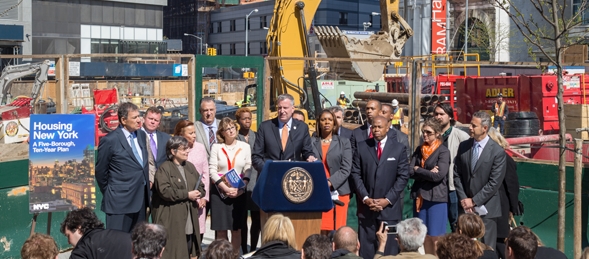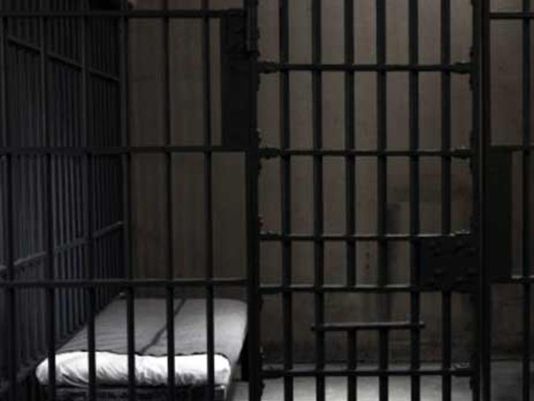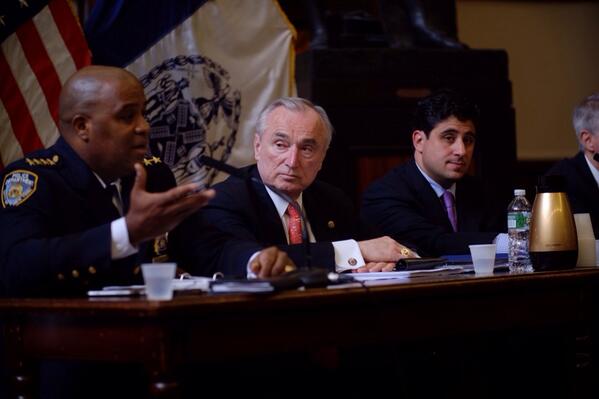A Commitment to Affordable Housing

Mayor de Blasio announces his housing plan (nyc.gov)
Over the past several weeks, those of us committed to meeting the housing needs of all New Yorkers have witnessed real progress, giving us great hope for the future of affordable housing in our city and state. Highlighted by the announcement of a comprehensive housing plan for New York City, along with a sound capital budget, we have learned that we have a Mayor and housing leaders who are true visionaries for dramatically growing New York City's affordable housing stock.
This was particularly evident when last week the de Blasio administration, as the old saying goes, put their money where their mouth is. By announcing $1.2 billion in additional capital funds as well as critical increases for HPD staff, the Mayor has demonstrated a significant and wise investment to immediately allow for the construction and preservation of units across the five boroughs.
For the Mayor's plan to succeed, however, it will take more than just the work of government, which is why, as the state's largest organization of affordable housing professionals, we have been called to action. Speaking at our 15th annual NYSAFAH housing conference earlier this month, Mayor de Blasio addressed the more than 1,400 attendees and outlined his guiding principles towards reaching 200,000 units over the next decade, including smart rezoning, eliminating regulatory hurdles, and streamlining permitting – all worthy objectives.
As he concluded, the Mayor made his case for why, in order to meet the plan's ambitious benchmarks – 8,000 units of new housing per year, for instance – all of us committed to affordable housing must work faster, more creatively, more efficiently, and, most importantly, must work together. This includes, among other priorities, placing an emphasis on bringing new construction to economically distressed neighborhoods, as well as preserving existing housing in order to ensure these buildings can remain affordable over time.
A true public-private sector partnership is the only way to ensure we are using every tool available to solve New York's housing crisis, and our organization is honored that the Mayor has asked for our collaboration in this effort. Our members stand at the ready. With decades of experience investing in New York's communities, we understand that the real goal of affordable housing is to ensure that every New Yorker has an opportunity to succeed. Affordable housing revitalizes entire neighborhoods, it creates jobs, and it allows our economy to grow.
This will not be an easy task. But as the Mayor said in his address: "We don't take on small and easy plans. We challenge ourselves on purpose." We believe this is the right approach – one that leaves little doubt that the future of affordable housing in New York City is bright. With strong leadership from government and a community of private sector professionals demonstrating their shared commitment to this cause, we are confident that we will achieve the goals for the coming decade.
To those within affordable housing industry who have not yet joined our efforts – whether developers, financiers, or others – we urge you to become a part of this growing community. Together, we can achieve great things, enabling future generations to experience a city and state that is affordable for all.
***
Jolie Milstein is the President & CEO of the New York State Association for Affordable Housing, a trade organization representing more than 300 affordable housing professionals statewide. For more information on NYSAFAH visit www.nysafah.org
The Case Against Solitary

With about one percent of our adult population behind bars, far more per capita than any other country, the United States also leads the world in the use of solitary confinement inside our prisons and jails. Inmates in solitary are typically locked in cells about the size of a parking space for 23 hours a day, with no human interaction and no regular access to educational or vocational training, psychological counseling, addiction treatment, or other rehabilitative programs. While overwhelming empirical evidence indicates that imposed social seclusion can lead to severe and often-irreparable psychological harms, extreme isolation punishments unfortunately remain a popular and widely accepted means of enforcing prison rules.
Despite recent reforms, solitary confinement punishments are more prevalent in New York than in any other state, with two prison facilities entirely dedicated to housing inmates in seclusion cells. Each year, approximately 4,500 inmates across the state are subjected to crushing isolation, often for months or years on end. The situation in New York City's jail system is especially dire. A September 2013 study prepared at the request of the City's Board of Correction noted that 7.5% of all City inmates are held in solitary at any given time.
The prevalence of solitary confinement as a disciplinary method of first resort flies in the face of what the Supreme Court once described as "the evolving standards of decency that mark the progress of a maturing society." Complete social seclusion and sensory deprivation have long been used as methods of psychologically dismantling captives for interrogation purposes. In recalling his experiences as a prisoner of war in Vietnam, Senator John McCain has described how solitary "crushes your spirit and weakens your resistance more effectively than any other form of mistreatment." The contemporary use of extreme seclusion as a jailhouse punishment is practically indistinguishable from its use as a wartime torture device, and the resulting mental health effects often last far beyond inmates' time in prison, with obvious negative implications for criminal recidivism.
Disciplinary actions and administrative decisions made behind prison walls are largely impervious to monitoring or supervision from the outside world, and prisoners who face solitary punishments generally have no recourse aside from a lengthy petition process which can last beyond the time of their initial prison sentence. Inmates have no right to legal assistance during disciplinary proceedings and must represent themselves against accusations brought by prison officials, many of whom work alongside the hearing officers who determine the inmates' guilt and set their punishment.
The use of solitary confinement for any reason, and for any length of time, is a fundamental human rights concern, and our Constitution requires that individuals' liberty interests should not be deprived without due process of law. While the Supreme Court has so far refused to provide incarcerated people with a right to legal assistance during disciplinary hearings, legislators and executives at the state and federal level should implement measures to provide counsel for inmates who face potential isolation punishments. To stem the abusive and reflexive use of solitary confinement, prisoners in disciplinary proceedings should be given competent legal assistance and a fair hearing before an independent hearing officer. In addition, those who are sentenced to a period of solitary confinement should be afforded regular access to legal counsel throughout their time in isolation.
The financial cost of providing competent representation in these situations would likely be offset by even a slight reduction in the use of solitary confinement. During a recent Congressional subcommittee hearing, Senator Dick Durbin of Illinois noted that it costs the federal government nearly three times as much to keep an inmate in an isolation cell than in the general prison population. Indeed, as Mississippi, Illinois and several other states have moved to reduce their use of solitary confinement in recent years they have realized tremendous cost savings in addition to decreased levels of prison violence.
In February, the de Blasio administration agreed to settle a lawsuit brought by the NYCLU and to limit the use of solitary confinement against teenagers while also placing caps on the length of isolation punishments for certain offenses, and Joseph Ponte, New York City's new DOC Commissioner, is known as a reformer who cut the rate of solitary punishments in Maine's prisons by two-thirds. New York State prison officials have also made efforts in recent years to reduce the prevalence of solitary confinement by prohibiting its use against mentally ill inmates. While these developments mark some degree of progress in addressing the serious problems caused by the pervasive use of solitary confinement, there are still thousands of people across the state at any given time who have been sent to "the hole" without adequate representation or an objective fact-finding process.
As a society, our standards of decency may continue to evolve, but every day in our prisons and jails thousands of people are subjected to debilitating psychological harms for want of effective advocacy and outside intervention. Human rights and the need for due process do not end at the prison gates, and as a mature society we should at the very least provide counsel and assistance to those who face what may be our last legal form of torture.
***
by Lucas Anderson
Contact: This email address is being protected from spambots. You need JavaScript enabled to view it. & @CriminalNYLaw
What's So 'Progressive' About 1000 New Police

Representatives from the NYPD testify at the City Council (William Alatriste)
The first showdown between Mayor Bill de Blasio and City Council Speaker Melissa Mark-Viverito, erstwhile progressive partners, has come over the police. In his budget last week, de Blasio shot down Mark-Viverito's call for 1000 new officers, but the speaker says she's sticking to her demand.
While some have criticized de Blasio for bringing back William Bratton as police commissioner because of his past association with Mayor Rudolph Giuliani and a variety of punitive policing tactics targeting youth, homeless people, and sex workers, the mayor held the line on the police budget. He has refused to add more officers despite extensive pressure from the police unions.
Mark-Vivertio, however, in her first major budgetary stand is demanding that the Mayor add 1,000 new officers. The $97 million price tag makes up 40% of the new spending the Council is proposing.
On Monday, the Black, Latino, and Asian Caucus (BLAC) held a press conference to reinforce the speaker's call for hiring more police. Council members pointed to recent upticks in crime in mostly minority communities as the primary reason for needing more police on the streets. But, will more police on the streets help reduce violent crime?
Several council members feel that local police precincts are stretched too thin, forcing them to rely on excessive and costly overtime. The speaker argues that some of the new expense of hiring more police will be recouped by reducing overtime costs—a laudable goal. However, much of the overtime accrued by police is not directly tied to staffing levels. Officers routinely rack up large amounts of overtime when they make arrests near the ends of their shifts. Standard procedure calls for the arresting officer to follow through on the processing of the arrest to ensure continuity of evidence and paperwork. Another big chunk of overtime comes from detectives and specialized units who are sometimes put on assignments that take up more than a standard shift in order to maintain the integrity of an investigation.
Reducing these forms of overtime would require a change in police procedures, not increased personnel. The one area where staffing increases might reduce overtime costs is in counterterrorism, but adding more cops there would do nothing to beef up local precincts. At a city council hearing on Tuesday Bratton said he intends to use the equivalent of 320 officers' worth of overtime to address increased crime in public housing, but according to the NYPD's own analysis most of this uptick is in domestic violence, which is largely impervious to increased policing.
During the Bloomberg years the number of police fell by 15%. But, over the last 20 years major crimes such as homicide and robbery are down 80% or more as are auto theft and larceny. Despite constant claims by many police leaders and politicians, the evidence is clear that these dramatic drops in crime are not primarily the result of policing. While there were significant changes in how policing was conducted in New York in the mid 1990s, the crime drop started well before that.
More importantly, the crime drop is an international phenomenon affecting cities and countries that made no changes in the way they conducted policing, added no new officers, and in some case pursued strategies antithetical to those used in New York. Berkeley law professor Franklin Zimring, in one of the most rigorous examinations of the issue, found that at best 20% of the reductions in robbery and burglary might be because of policing changes specific to New York, and even this was based on a process of eliminating other explanations, rather than the identification of clear positive evidence. In addition, there are numerous studies that show that there is no causal relation between increasing the number of police and reducing crime. During the high crime periods of the 1980's and 90's New York had one of the highest concentrations of police per capita of anywhere in the country, but it seemed to have no effect on explosive outbursts of crime.
Throughout the city and around the country there is a growing awareness that there are ways to produce public safety that don't rely on police, courts, and prisons. New York has a string of community based organizations, such as SOS Crown Heights, Man Up!, and the South Jamaica Cure Violence Program, that are working with young people in high crime areas to teach them alternative conflict resolution methods, help them overcome problems at home, and mentor them for success in school, work, and life.
The City Council has been an important supporter of these groups, using some of its discretionary money to fund them through the Council's Anti-Gun Violence Task Force co-chaired by Jumaane Williams from Brooklyn and Fernando Cabrera of the Bronx. Unlike Mayor Bloomberg, Mayor de Blasio has put some resources into the baseline budget for these groups. The Task Force, however, asked for more and is trying to find the money. The difference: about $6 million.
One of the things that's been learned by these groups and many researchers is that increased and aggressive policing actually makes their work harder. The constant harassment and criminalization of young people pulls them out of school, disrupts their home life, reduces their self-esteem, immerses them in a culture of violence, gangs, and professional criminality, and inhibits their future job prospects.
The main culprit in this dynamic has been the aggressive pursuit of the War on Drugs. The NYPD continues to make tens of thousands of low-level drug arrests every year. After a short-lived drop off during the mayoral transition, marijuana arrest rates have again spiked to their previous levels of 30,000 a year. And these arrests are highly concentrated in communities of color. According to an analysis by Queens College Sociologist Harry Levine, in the first 3 months of 2014, in predominantly white Park Slope, police made 7 marijuana possession arrests and in Carroll Gardens and Red Hook, they made 12. At the same time police made 111 of these arrests in Bedford Stuyvesant, 130 in Crown Heights and 438 in East New York, all neighborhoods that are mostly black and Latino.
Commissioner Bratton has made it clear that he opposes decriminalization of marijuana (despite the fact that private possession is already decriminalized) and will continue to aggressively enforce the drug laws. More police on the streets invariably means more low level arrest, more criminalization of young people, and more of a siege mentality in high crime areas. As Bratton pointed out in his first stint as Commissioner, police are not trained to be social workers, they are trained to enforce the law through arrests.
It is ironic that the members of the BLAC, who represent mostly poor minority neighborhoods, are prioritizing increased spending on new police while decrying the lack of resources for community-based anti-violence initiatives. Politicians in high crime communities like those represented by BLAC members need to quit looking to the police to solve their communities' problems. We cannot arrest our way out of gangs, drug abuse, and or even violent crime. It's time to move beyond the failed policy of throwing more cops at the crime problem. To really produce long-term safety we need to support truly progressive programs that invest in the lives of young people in high crime areas, not in more police.
***
Alex S. Vitale is Associate Professor of Sociology at Brooklyn College and author of City of Disorder: How the Quality of Life Campaign Transformed New York Politics
Contact: This email address is being protected from spambots. You need JavaScript enabled to view it. & @avitale




